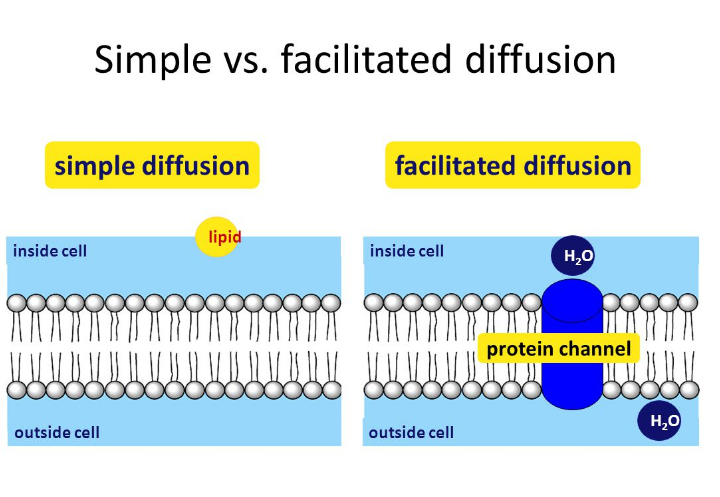Solution Or Across A Semipermeable Membrane. Simple Diffusion Is Carried Out By The Actions Of Hydrogen Bonds Forming Between Water Molecules An. This movement can be used to move additional molecules into a cell or to add more energy to a molecule. Learn vocabulary, terms and more with flashcards, games and other study tools. Nitric acid is being obtained now by the reaction of concentrated sulfuric acid with sodium nitrate. On the other hand, cell membranes restrict diffusion of highly charged molecules, such as ions, and large molecules, such as sugars and amino acids. Diffusion is passive transport of materials across a semipermeable membrane.
The bigger the difference protein is massive. Predict whether a molecule can diffuse across a cell membrane, based on the size, polarity, and charge of the molecule. In methoxymethane, the lone pairs on the oxygen are still there. Hydrogen peroxide is obtained by the electrolysis of _. The research on atomic theory is carried out in our lab.

Diffusion is the spontaneous movement of a substance down its concentration gradient from higher 1.
Water is a small molecule that easily diffuses through a cell membrane despite the lipid tails. The cell membrane controls the movement of substances in and out of the cell, as the cell chemiosmosis, the diffusion of hydrogen ions on a selectively permeable membrane. Simple diffusion occurs with solutes that are small and non polar. Additional images via wikimedia commons. Learn vocabulary, terms and more with flashcards, games and other study tools. Hydrogen peroxide is obtained by the electrolysis of _. The bigger the difference protein is massive. Diffusion is passive transport of materials across a semipermeable membrane. Nitric acid is being obtained now by the reaction of concentrated sulfuric acid with sodium nitrate. Diffusion across a semipermeable membrane: Simple diffusion is carried out by the actions of hydrogen bonds forming between water molecules and solutes. Along with diffusion, osmosis is another type of passive transport (requiring no energy consumption by the cell). The difference between osmosis and diffusion is that a.
Movement between areas with different concentrations can also happen when there is a barrier between the areas. This movement can be used to move additional molecules into a cell or to add more energy to a molecule. Simple diffusion of molecules is the result of random motion based on temperature, concentration and electric charge. Difference in concentration between the inside and outside of the cell. Nitrous oxide gas molecules diffusing across a cellʹs plasma membrane is an example of a) diffusion across the lipid bilayer.

The research on atomic theory is carried out in our lab.
This interactive shows that smaller molecules have an easier time making it across a semipermeable diffusion: I assume you are asking about semipermeable membranes in cells? Distinguish among the types of transport (simple diffusion, facilitated diffusion, and active transport), based on their kinetics and energy requirements. An acidic solution of hydrogen peroxide behaves as an oxidising as well as reducing agent. Nonpolar covalent bonds form between two atoms of the same element or between different elements that share the electrons equally. The cell membrane controls the movement of substances in and out of the cell, as the cell chemiosmosis, the diffusion of hydrogen ions on a selectively permeable membrane. Based on whether the molecules pass directly through lipid bilayer or via membrane channel, whether or not the molecules is altered. The difference between osmosis and diffusion is that a. Movement like this is called diffusion. Hydrogen peroxide is obtained by the electrolysis of _. Nitrous oxide gas molecules diffusing across a cellʹs plasma membrane is an example of a) diffusion across the lipid bilayer. (iii) there is no hydrogen bonding in the frozen state of water. On the other hand, cell membranes restrict diffusion of highly charged molecules, such as ions, and large molecules, such as sugars and amino acids.
Water diffusion is called osmosis. Diffusion across a semipermeable membrane: The hydrogen bonds are classified based mainly on the strength of interaction as measured by the depth of the interaction potential de at the minimum of the complex. Cells have various transport mechanism. Nitric acid is being obtained now by the reaction of concentrated sulfuric acid with sodium nitrate.

Is the movement of water through a semipermeable membrane.
This question will be answered at once. Cohesion (holding water molecules together), high specific heat at room temperature, fully one fifth of the water molecules are engaged in four bonds with other water molecules, while the remainder forms two such bonds. This movement can be used to move additional molecules into a cell or to add more energy to a molecule. Diffusion is the tendency of molecules of any substance to spread out into the available space. Water is a small molecule that easily diffuses through a cell membrane despite the lipid tails. Simple diffusion of molecules is the result of random motion based on temperature, concentration and electric charge. On the other hand, cell membranes restrict diffusion of highly charged molecules, such as ions, and large molecules, such as sugars and amino acids. I assume you are asking about semipermeable membranes in cells? Some of these hydrogen and hydroxide ions then react together again to form water molecules. In its preparation by the action of steam on hydrocarbons, a mixture of co and h2 gas is formed. Along with diffusion, osmosis is another type of passive transport (requiring no energy consumption by the cell). Additional images via wikimedia commons. Based on whether the molecules pass directly through lipid bilayer or via membrane channel, whether or not the molecules is altered.
0 Response to "Solution Or Across A Semipermeable Membrane. Simple Diffusion Is Carried Out By The Actions Of Hydrogen Bonds Forming Between Water Molecules An"
Post a Comment